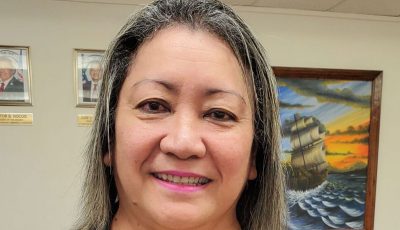Bill to get govt employees aboard insurance program nixed
A policy call to get all active government employees under government insurance and thereby lower premiums across the board has been vetoed, after officials determined that a Senate amendment to retroactively get retirees back into the system would effectively neuter the original intent of the bill.
Both Attorney General Edward Manibusan and Finance Secretary Larissa Larson noted problems with the Senate amendment to get an additional 1,698 retirees on the government insurance program. They say a funding source to shoulder this burden has not been identified and would actually lead to greater insurance premiums, as retirees are expected to make more insurance claims.
The original intent of the bill was to place the Group Health and Life Insurance under the Department of Finance and to prohibit the use of public funds for non-GHLI insurance benefits. But the Senate amendment to allow retirees to re-enroll in GHLI would apparently skew the bill’s intent, according to the officials, and possibly—if a significant amount of retirees re-enroll—make insurance unaffordable for all.
Acting governor Ralph DLG Torres vetoed House Bill 19-37 and its amendments on Monday.
Rep. Angel Demapan (R-Saipan)—the bill’s author—told Saipan Tribune Monday he would be redrafting the bill based on Torres’ recommendations.
In his veto message to both chambers of the Legislature, Torres said he agrees with the intent and principles of this legislation.
“However, this legislation runs the risk of increasing costs when its overall intent was to make premiums more affordable for every enrollee…The projected monetary effects of legislation of this type must be understood as best possible before the CNMI commits itself to following this course of action,” Torres said.
The acting governor urged the Legislature to revisit the bill’s goal to get affordable coverage for employees and retirees.
No funding source
In a letter to Torres Monday, Larson said she supports the bill, noting that many retirees have been left without health insurance coverage due to prohibitions that restrict them from enrolling as a result of not meeting a six-month window before their retirement.
However, she said, there are currently 3,017 CNMI retirees/survivors of retirees and only 1,324 of these retirees are enrolled in the GHLI program as of Oct. 31, 2015.
If the bill were signed into law, about 1,693 additional retirees would be entitled to medical insurance coverage, she said.
While the bill would allow retirees the option to enroll and get the health care coverage that they are in dire need of—from a fiscal perspective—the bill does not identify a source of funding for the government match of the insurance benefits of these retires, she said.
“…Thus adding to the unfunded liabilities that the government will then struggle to address, at a time where it is already struggling to recover from the aftermath of typhoons Soudelor and Champi,” she added.
Larson said an additional source of funds to cover the additional enrollees will need to be identified, as the bill does not address this.
Allowing retiree enrollment, she also said, will not necessarily ensure retiree health coverage.
“With the rising cost of medical insurance, many of the lower salaried retirees do not earn a pension that is sufficient to cover the cost of their medical insurance, and thus, the issue of lack of coverage will remain,” she said.
Larson explained that retirees with pensions that are lower than the cost of health insurance will be faced with the choice of finding additional financial resources to maintain insurance payments or continue to remain uninsured despite the best intent of the bill.
Rising costs
Larson also noted the rising cost of health insurance in the CNMI. A primary reason for this, she said, is the number of insured with chronic conditions that drive up the costs of coverage for the insurance providers.
Insurance companies charge by calculating risk and charge based on their anticipated expenses.
Insurance companies mitigate their risk by balancing their portfolio with a younger population that has fewer health care needs—typically the average government employee—with the older population of enrollees with greater health care and who use their insurance more often and for costlier services.
“The expense of the retirees…will further drive up the cost of health insurance over the years and this will be compounded further by the reduction in government employees who may opt out of insurance plans due to the ever increasing health insurance rates,” Larson said.
Greater experience, higher premiums
In his letter to Torres in November, Manibusan said this ratio of actives to retirees in the system is important because insurance premiums are based on claim experience. “The greater the experience, the higher the premium,” he said.
On average, Manbisusan said, retirees make more claims—the claim experience of a retiree is approximately 60 percent greater than the claim experience of an active employee. Given this, if a significant number of retirees re-enroll in the program, it would likely lead to significant increase in premiums.
Over the past few years, the GHLI program has seen significant increases in premiums and the administration has sought ways to temper those increases, Manibusan said.
Part of the bill addresses the issue by preventing public funds from being expended on insurance benefits that are not provided under GHLI—with the idea that this policy would encourage autonomous agency employees to participate in the GHLI program and the percentage of retirees in the plan would decrease.
However, Manibusan notes, any resulting increase in active enrollment will likely be neutralized by retiree re-enrollment, and thus no savings will be realized.
Moreover, he said, if the number of retirees who re-enroll is greater than the number of actives who enroll, it could result in an increase in premiums.
“The impact of allowing approximately 1,500 retirees to re-enroll…should be thoroughly assessed before opening enrollment. Allowing retirees to re-enroll will likely result in increased premium rates and could, depending on how many retirees re-enroll, make the plan unaffordable for all,” he said.



























